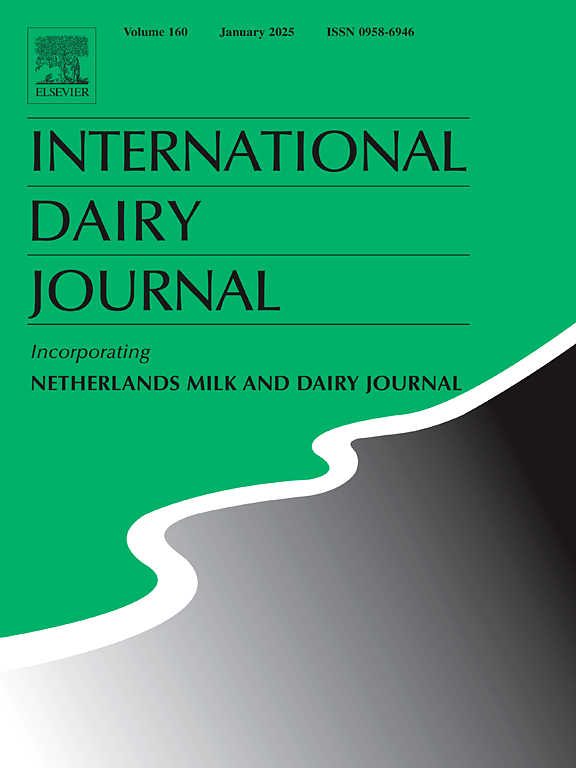Semicarbazide formation during processing and storage of dairy protein ingredients
IF 3.1
3区 农林科学
Q2 FOOD SCIENCE & TECHNOLOGY
引用次数: 0
Abstract
Semicarbazide is often used as a marker metabolite for detection of illegal nitrofurazone use in agricultural products, but is not a reliable marker metabolite for analysis of nitrofurazone abuse dairy products because it can also be formed during processing and storage. To further investigate that the semicarbazide found in dairy protein ingredients is formed during processing, rather than from nitrofurazone abuse, a series of studies were conducted. Almost 500 commercial dairy protein ingredients were manufactured and analysed, and semicarbazide was detected in 22.4% of samples. Semicarbazide was detected in <10% of caseinates and >20% of all whey protein concentrate (WPC) samples analysed. Notable differences were observed between different WPC subcategories in terms of the frequency of detection and levels of semicarbazide. Higher semicarbazide levels were observed in WPC with a higher protein content or that were fat-rich. Importantly, semicarbazide was not detected in either the raw materials or intermediate products during dairy protein ingredient production but were only found in final, dried, dairy protein ingredients. This indicates that semicarbazide formation likely occurs during (spray-)drying or during storage after manufacture. Higher semicarbazide levels were found at higher storage temperature and higher water activity of the ingredients. No other nitrofuran metabolites were detected in any of the samples. The investigations presented in this report confirm previous reports that semicarbazide found in dairy ingredients is not present in raw materials but formed during processing and storage.
乳品蛋白原料加工和储存过程中氨基脲的形成
氨基脲常被用作检测农产品中非法使用硝基呋喃酮的标记代谢物,但由于其在加工和储存过程中也会形成,并不是分析硝基呋喃酮滥用乳制品的可靠标记代谢物。为了进一步调查乳制品蛋白成分中的氨基脲是在加工过程中形成的,而不是由于硝基呋喃酮的滥用,进行了一系列研究。生产和分析了近500种商业乳制品蛋白成分,在22.4%的样品中检测到氨基脲。在10%的酪蛋白酸盐和20%的乳清浓缩蛋白(WPC)样品中检测到氨基脲。不同WPC亚类在检测频率和氨基脲水平方面存在显著差异。蛋白质含量高或脂肪含量高的WPC中,氨基脲含量较高。重要的是,在乳制品蛋白成分生产的原料或中间产品中均未检测到氨基脲,而仅在最终的干燥乳制品蛋白成分中发现。这表明氨基脲的形成可能发生在(喷雾)干燥或生产后的储存过程中。在较高的储存温度和较高的水活度条件下,氨基脲含量较高。在所有样本中均未检测到其他硝基呋喃代谢物。本报告中提出的调查证实了以前的报告,即乳制品成分中发现的氨基脲不存在于原材料中,而是在加工和储存过程中形成的。
本文章由计算机程序翻译,如有差异,请以英文原文为准。
求助全文
约1分钟内获得全文
求助全文
来源期刊

International Dairy Journal
工程技术-食品科技
CiteScore
6.50
自引率
9.70%
发文量
200
审稿时长
49 days
期刊介绍:
The International Dairy Journal publishes significant advancements in dairy science and technology in the form of research articles and critical reviews that are of relevance to the broader international dairy community. Within this scope, research on the science and technology of milk and dairy products and the nutritional and health aspects of dairy foods are included; the journal pays particular attention to applied research and its interface with the dairy industry.
The journal''s coverage includes the following, where directly applicable to dairy science and technology:
• Chemistry and physico-chemical properties of milk constituents
• Microbiology, food safety, enzymology, biotechnology
• Processing and engineering
• Emulsion science, food structure, and texture
• Raw material quality and effect on relevant products
• Flavour and off-flavour development
• Technological functionality and applications of dairy ingredients
• Sensory and consumer sciences
• Nutrition and substantiation of human health implications of milk components or dairy products
International Dairy Journal does not publish papers related to milk production, animal health and other aspects of on-farm milk production unless there is a clear relationship to dairy technology, human health or final product quality.
 求助内容:
求助内容: 应助结果提醒方式:
应助结果提醒方式:


